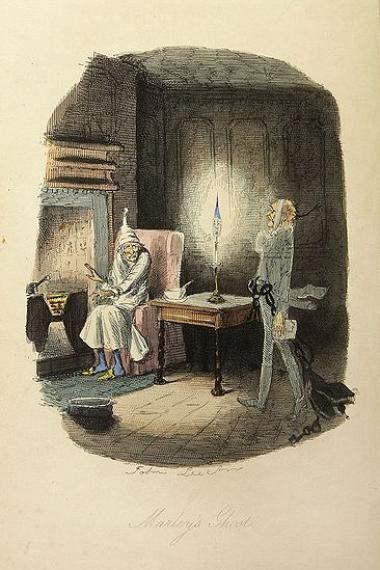
The Real Dickens
THE SOURCE: "Why Dickens Wrote A Christmas Carol" by Michael Timko, in Current, March–April 2002.

THE SOURCE: "Why Dickens Wrote A Christmas Carol" by Michael Timko, in Current, March–April 2002.
 Almost as familiar as Charles Dickens’s A Christmas Carol is the received tale behind its creation, how the cash-strapped author cobbled together the redemptive morality play of miserly Ebenezer Scrooge with the Victorian sentimentality of the Cratchit family to create his classic Christmas confection. Timko, professor emeritus of English at the City University of New York, detects a deeper design. His attention is drawn to the disparity between the "evocative scenes of goodwill and peace on earth in the Christmas fiction" and the facts that are now known about Dickens, "the acquisitive author and heartless husband." As Dickens’s own daughter once remarked, "Nothing could surpass the misery and unhappiness of our own home."
Almost as familiar as Charles Dickens’s A Christmas Carol is the received tale behind its creation, how the cash-strapped author cobbled together the redemptive morality play of miserly Ebenezer Scrooge with the Victorian sentimentality of the Cratchit family to create his classic Christmas confection. Timko, professor emeritus of English at the City University of New York, detects a deeper design. His attention is drawn to the disparity between the "evocative scenes of goodwill and peace on earth in the Christmas fiction" and the facts that are now known about Dickens, "the acquisitive author and heartless husband." As Dickens’s own daughter once remarked, "Nothing could surpass the misery and unhappiness of our own home."
It’s true that when the 31-year-old Dickens wrote A Christmas Carol in late 1843, he hoped it would be a big moneymaker. Smarting from the disappointing response to his gloomy novel Martin Chuzzlewit (1843), Dickens dreamed of reaping "a Thousand clear" on his holiday tale. The initial sales in England brought in just £230, however, and the author’s impolitic remarks while on a tour in America hurt sales there as well. Dickens then turned to giving public readings, which launched A Christmas Carol’s enduring popularity.
Dickens, says Timko, often remarked that he wrote "not merely to entertain readers and make himself rich, but to promote individual ‘salvation’ and bring about social reform." He may well have had his own salvation and reform in mind. He was no prince. His father landed in a debtors’ prison when Dickens was 12, and he was forced into miserable labor at a boot-blacking factory. This trauma forever colored his attitude toward money; "like Scrooge, he seemed to put it ahead of everything," says Timko. Early trauma neither explains nor excuses his treatment of his wife, Catherine, mother of his 10 children. His infatuation with a young actress led Dickens to banish his wife to a walled-off section of their own home; eventually she moved out.
Through Scrooge’s transformation, Dickens shows "that anyone can be converted from a harsh, complacent, selfish worldview to one in which love, hope, and charity are possible." Maybe even Charles Dickens. That he failed to achieve such a transformation, says Timko, does nothing to lessen the genius of his art.
Image credit: Marley's Ghost from Dickens' A Christmas Carol